This month I began yet another web side-project: a weekly newsletter called Web Technology News on the Ghost platform. I currently have two other active websites: Cybercultural, my internet history site that I run via Eleventy and Cloudflare (and Buttondown for email delivery); and my personal website, ricmac.org, which has been running on WordPress for many years and includes this irregularly updated blog.
In addition to these three sites that I actively run in 2025, I also have recent experience with Substack. I started Cybercultural on Substack in May 2019, as a newsletter, and was on that platform until January 2024. At that point, I migrated to Eleventy and converted Cybercultural into what I’m now calling an “online magazine.”
If you’re wanting to start an independent web publication in 2025, you’re likely considering all these products that I use / have used:
- Substack; the big kahuna of newsletters.
- Ghost; the leading open Substack alternative.
- WordPress; the big kahuna of open CMS.
- Eleventy; a small but powerful static site generator for running a content website.
There are, of course, many other services you could consider:
- Other open web options, like Micro.blog, Drupal, Craft, or [name your favorite blog/newsletter tool]. The Indieweb website lists a bunch of great services, which I encourage you to look at if you want to consider everything.
- Commercial web builder services like Squarespace, Wix, or WordPress.com. Those are all solid choices if it’s ease-of-use you’re looking for and you don’t mind paying for it.
- Products doing something a bit different and that have a thriving community; here I’m thinking specifically of Neocities, a modern take on the famous 1990s website builder, GeoCities. Tumblr is also still kicking around.
But for this post, I will focus on the four products I have recent experience with. Most people these days want to start an email newsletter, so let’s start with that.
Newsletters: Substack or Ghost?
Personally, I think the current, email-first format of newsletters is on the wane. There’s still a lot of potential with fediverse distribution of newsletters, though, which I’ll get into shortly. But let’s address email first.
I don’t know about you, but I’ve signed up to numerous email newsletters over the past several years. So, each day, a bunch of emails flow into the “forums” tab of my Gmail inbox — and most of them are destined to remain there, unopened. Here’s my Forums tab right now, as I write this post early on a Thursday morning:
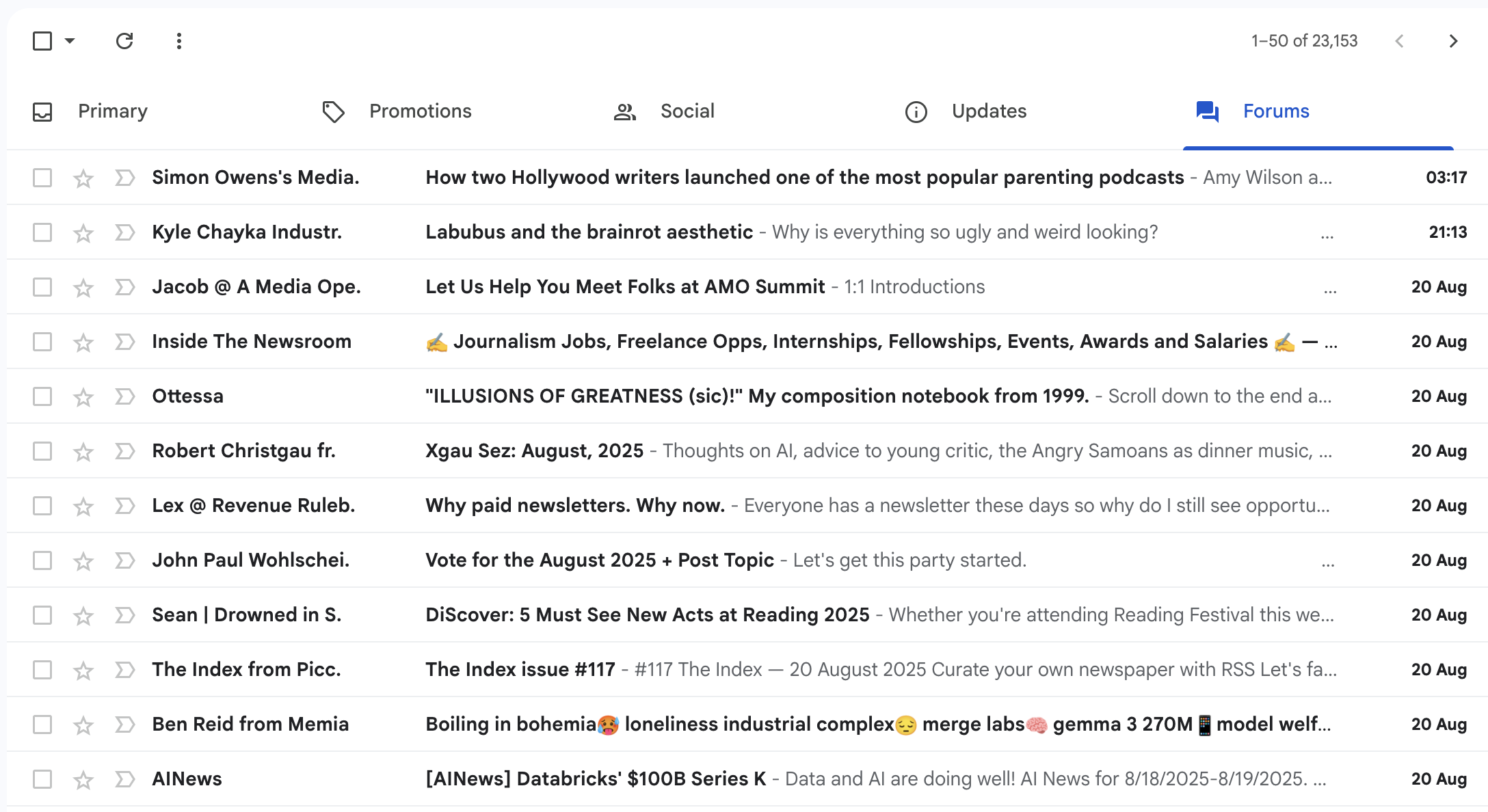
All of those emails are as yet unopened. I may open one or two later today, but — to be perfectly honest — most of them I won’t get around to reading… because who has time these days, etc.
The leading email newsletter platforms are well aware of the problem of clogged inboxes. Substack initially promoted itself as a way to discover independent voices outside of algorithmic social media like Twitter (now X) and Facebook. But now Substack is itself becoming a social media service; it encourages its users to download its app and post “notes” in addition to newsletters. That’s Substack’s strategy for tackling the problem of email overload; essentially it’s becoming X, complete with the sometimes toxic content.
I had actually removed the Substack app from my phone many months ago, but to get a screenshot I downloaded it again. While you are getting the app set up, Substack bombards you with prompts to receive app notifications and subscribe to various other Substack publications — all part of its VC-fueled growth strategy (a.k.a. enshittification).
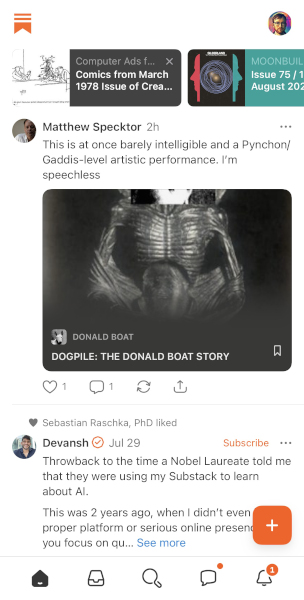
On the positive side: as a newsletter publishing system, Substack is a slick product and has powerful network effects… and it’s free. But as a proponent of the open web, I can’t recommend the product to you. Like X and Facebook, ultimately Substack is a centralized, corporate platform that traffics in dubious ‘engagement farming’ practices. Not to mention that hate speech still appears to thrive there (another reason for my migration in January 2024).
Ghost is rightly seen as the leading alternative to Substack. In many respects it closely resembles Substack as a product, but with more of an open web focus. For instance, Ghost also has a “Notes” feature, which is part of its fediverse integration plan. In other words, your notes get syndicated out to platforms like Mastodon and (with the help of bridging technology) Bluesky.
However, I’ve discovered that Ghost’s federation is quite a limited implementation so far.
In practical terms, to participate in the fediverse via Ghost you need to operate inside the Ghost UI. You have a “Reader” that functions as a kind of RSS Reader for Ghost newsletters you subscribe to. This is where your “Notes” live too. Here’s what my Notes profile looks like, as a brand new Ghost publication:
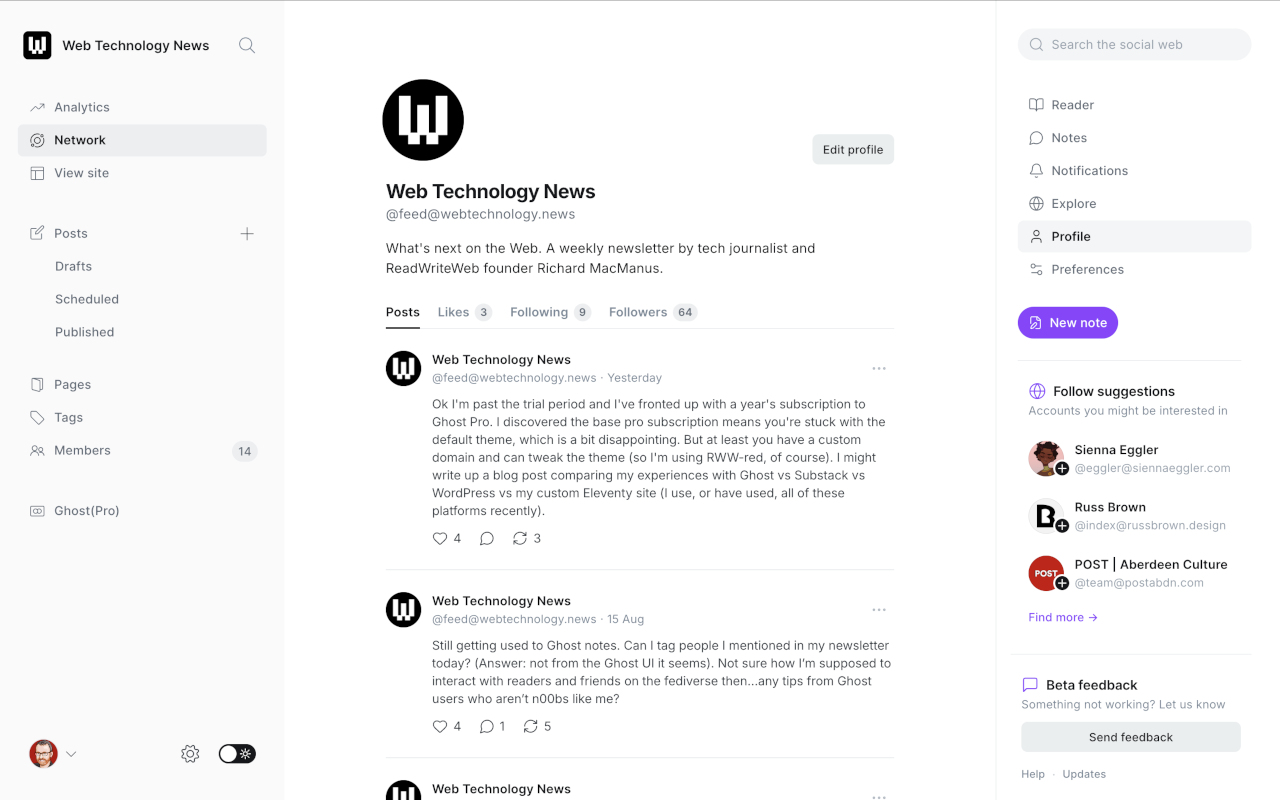
You can subscribe to my feed on Mastodon and other fediverse services. Here’s what it looks like on Mastodon:
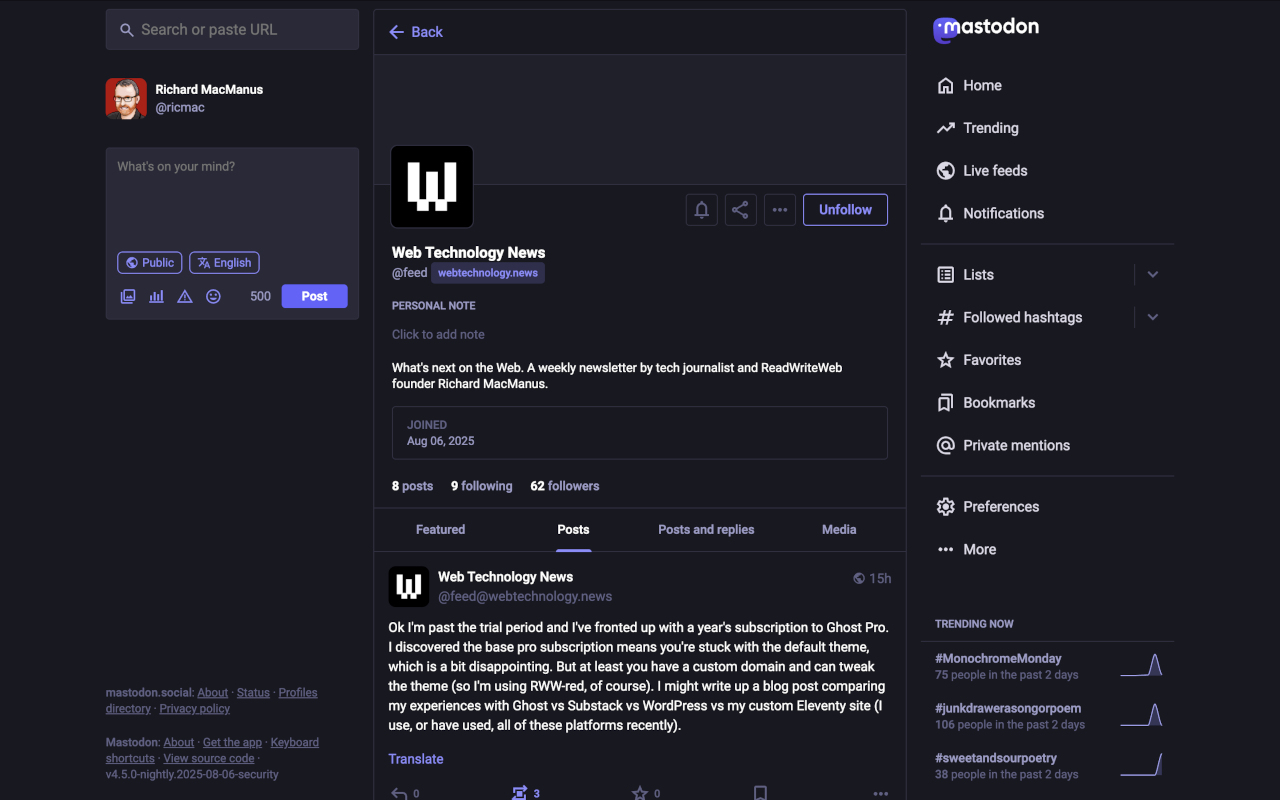
Some elements don’t sync up — e.g. it shows 62 followers on Mastodon, but 64 in Ghost’s UI. Also, if you update your profile on Ghost, it can take a while to filter through to the fediverse. That said, I have found that when you post a note from Ghost, it shows up pretty much straight away.
There are other federation peculiarities — e.g. following the lead of existing Ghost publications like Platformer and 404 Media, I named my Ghost handle “@feed”. But it looks odd when you link to it in Mastodon, because you lose the branding of your site:
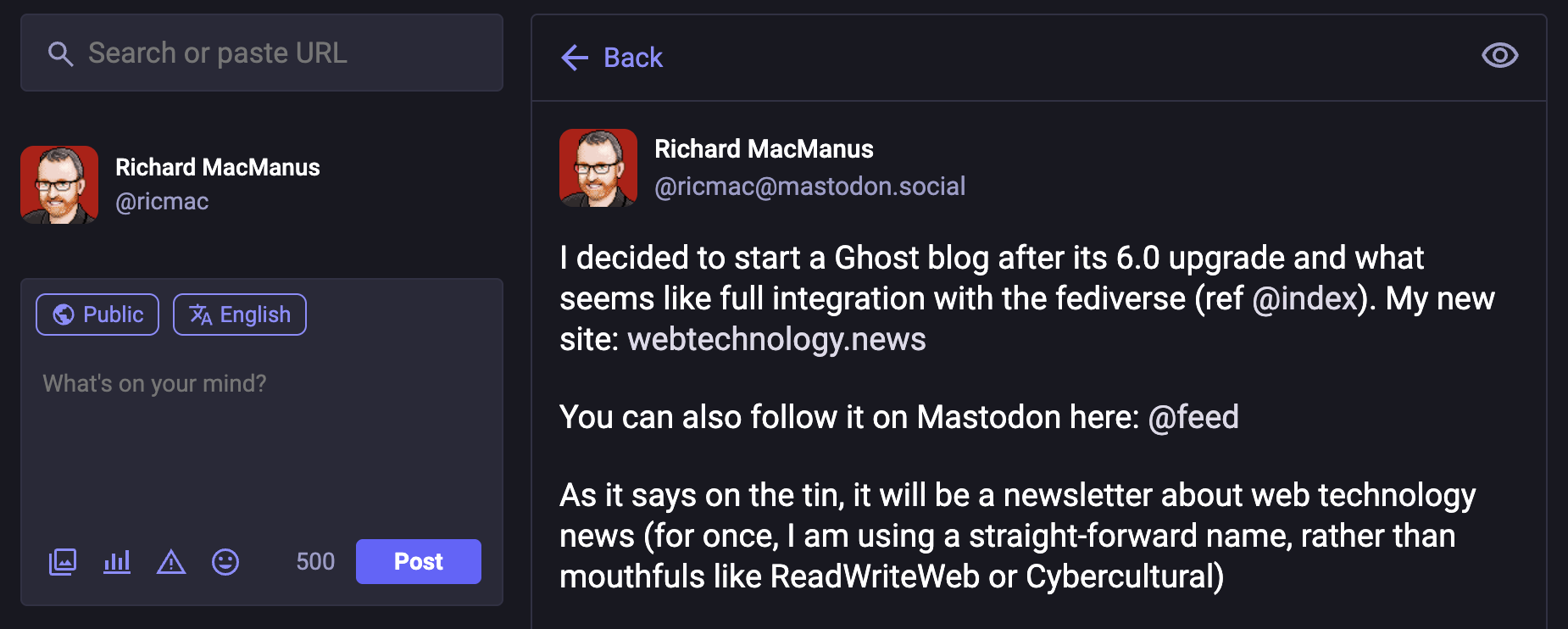
Maintaining a fediverse presence via Ghost also has its problems. Firstly, I have to post a note from within Ghost’s UI — I can’t do it from Mastodon or one of the Mastodon apps I use (Phanpy on computer, Mona on iPhone). Likewise, I can only see notifications from within Ghost. I’ve found this difficult to manage, especially on mobile. Unlike Substack, Ghost doesn’t have an app, so I have to have a browser window open on my iPhone in order to either post a note or keep track of notifications (e.g. someone replying to me).
So, engagement with the wider fediverse using Ghost’s notes is fairly limited. All these nitpicks aside, it’s a good start and I know the Ghost team is working hard to make fediverse integration better over time. I certainly appreciate the effort Ghost is making to be a part of the open social web — it’s a big reason why I’m using the product now. As I said, I think email distribution nowadays is problematic (and expensive!), so I want to see the web become a first-class platform for newsletters. It’s not there yet, but the fediverse is The Way.
As for writing newsletters or blog posts, Ghost is as good as (if not better) than Substack. You have more flexibility with themes than Substack — although, you can only use the default theme if you’re on the base pro subscription, which is a little disappointing considering the cost. And that is probably my main issue with Ghost: it’s pretty expensive. The “starter” level (“for solo blogs & newsletters”) is US$15-18 per month, depending on whether you pay annually or monthly. To get more than one theme, you’re paying US$29-35 per month to be on the “publisher” level.
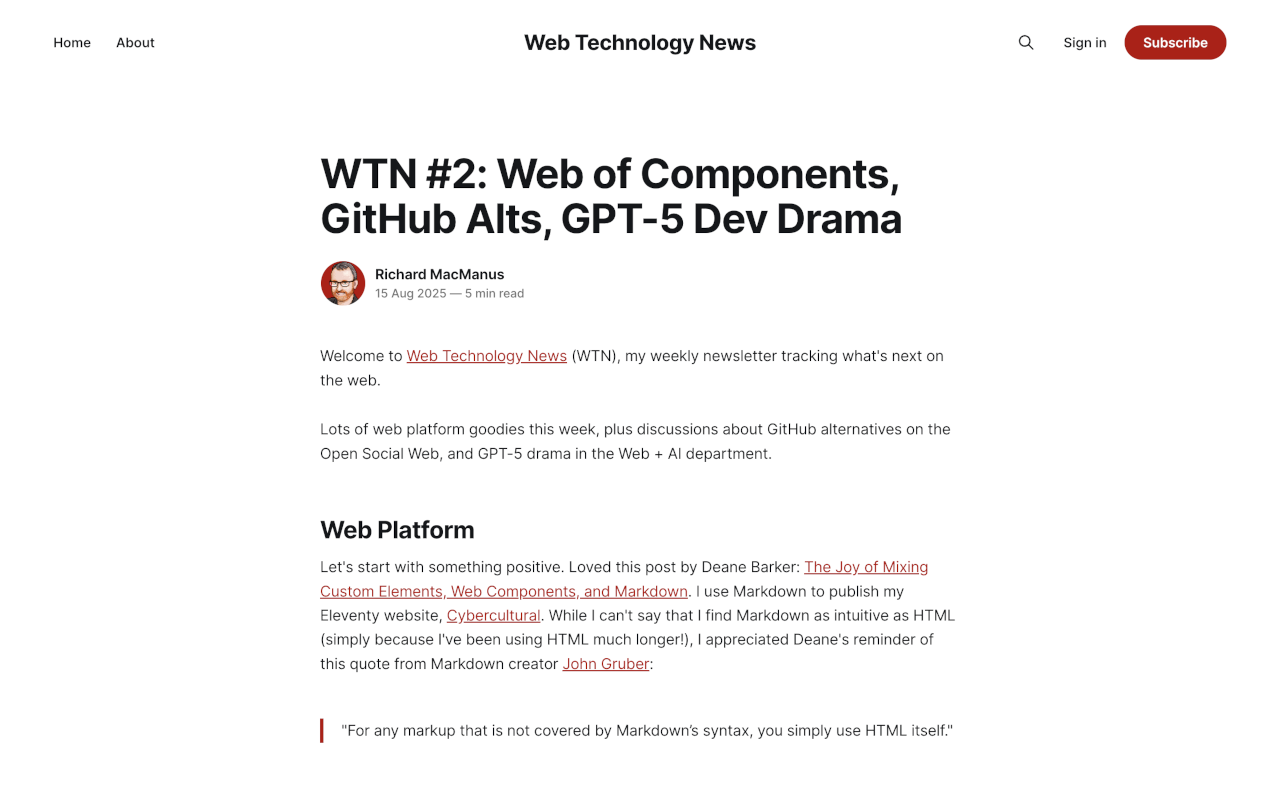
I hope that over time, the Ghost community — and by extension the fediverse (a.k.a. open social web) community — expands so that it becomes somewhat comparable in size to Substack’s user base. That’s an open web dream to get behind, even if it means forking out more money than you’d like to. But there’s a ways to go yet.
Blogs & Magazines: WordPress or Eleventy?
Part of the reason I moved off Substack in January 2024 was to have more control over the design of my website, Cybercultural. I also wanted to ‘practice what I preach’ on the web development topics I write about in my day job (senior editor at the tech news and analysis site, The New Stack). So I chose to migrate to Eleventy, a static site generator that many web developers use and love.
Eleventy got me back into the world of web coding, which I hadn’t fully done since running my Web 2.0 blog ReadWriteWeb on Movable Type back in the 2000s. So over the past couple of years, I have customized Cybercultural a great deal. I love that it’s now a truly independent website, with its own custom design and features.
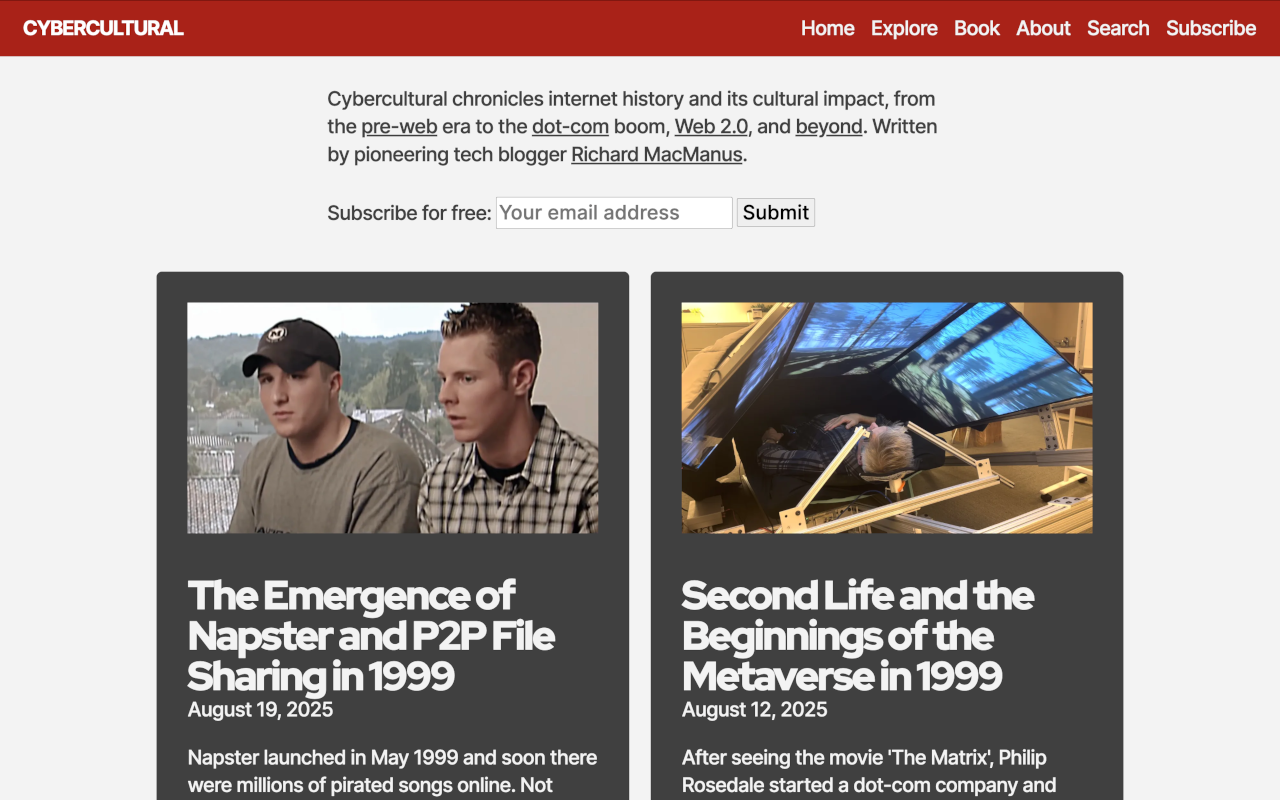
Also, I am now fully in control of optimizing my website in terms of web performance. Despite being a multimedia-rich website (I typically include 8-10 images in each post), I am proud to say that Cybercultural has a near-100% Core Web Vitals score and it loads real fast in the browser. Every post on the site is no more than 2MB, and usually they’re 1MB or under. For an image-rich web page, that’s as good as it gets. I use the Eleventy image plugin to achieve these results.
One of the perhaps unexpected things about moving to Eleventy is that Cybercultural became hard to categorize. It’s not a subscription newsletter anymore and it’s also not a blog. I’ve settled on “online magazine” as the best way to describe it. But I actually love this — the open web is about exploring new formats, and I think I’m doing that with Cybercultural thanks to Eleventy and all the other tools I use (Visual Studio Code, GitHub, Cloudflare, Buttondown for email, etc.).
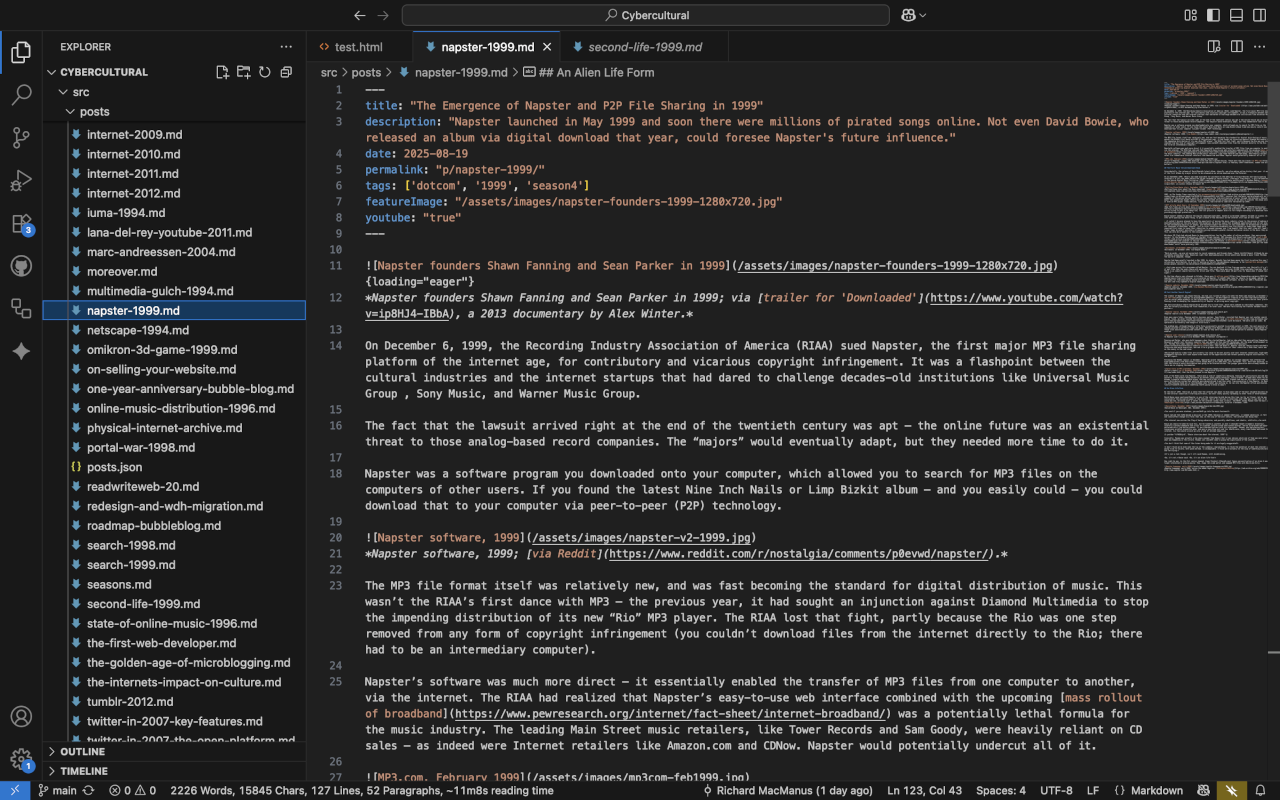
In terms of cost, it’s all free to use…except for Buttondown. I pay US$29 per month to send out Cybercultural updates via email. As with Ghost, that’s too expensive, really. But as Molly White has detailed, email newsletters have a lot of costs built into them — whether or not you host with the likes of Ghost or Buttondown, or self-host.
Overall, I have no hesitation in recommending Eleventy to you — and Buttondown, if you want to add email delivery — if you’re a web tinkerer like me and know your way around Visual Studio Code and GitHub.
But most people would prefer something simpler, and so WordPress is still seen as the go-to there (sadly, Movable Type is long gone).
I’m using WordPress to write this post, and it’s still a fine product. Although, I continue to shun the Gutenberg blocks UI that WordPress now foists on you by default (I have the ‘Classic Editor’ plugin installed, which gives you the old UI). And compared to using Eleventy, there is less ability to customize your site. But there are plenty of themes to choose from in WordPress and the plugin ecosystem is diverse. There’s even a plugin for ActivityPub, a.k.a. federation, which I installed some time ago. So you can subscribe to ricmac.org in Mastodon, although I wouldn’t recommend it since I’m not very active here.

Despite plugins that can modernize WordPress, using it feels old-fashioned to me nowadays. Even on the backend, I need to fiddle around with PHP files in a clunky “File Manager” UI provided by my web host. I’ve gotten so used to the slickness and power of VS Code, GitHub and Cloudflare for Cybercultural; plus I love having all my files living on my computer’s file system, within easy reach. So it feels like I’ve traveled back to the 2000s every time I open WordPress.
Note: there is a WordPress-to-Eleventy migration tool, provided by Eleventy itself, so at some point I might move my personal website over to Eleventy as well. It’s just not a priority for me right now…and also, I like keeping a toe in the WP world, because it allows me to continue monitoring the ecosystem.
In terms of costs, WordPress itself is free (for the .org software), but I paid roughly £40 per year to Hostinger for a 4-year deal on web hosting — which is excellent compared to Ghost and Buttondown. I need to be careful about the renewal cost though, as it will more than double if I leave the ‘auto-renew’ option on (I just turned it off now, having recently been bitten by expensive auto-renewals from a couple of insurance companies!).
Conclusion
It might sound like I’ve been a bit harsh on Ghost in this post, but I am enjoying using the product. It needs more time for the fediverse integration to mature, sure, but that’s because it’s all so new. I 100% support Ghost’s vision of offering an open alternative to Substack, so that’s why I signed up for a year. My goal is to slowly build an audience with Web Technology News — who knows, I may eventually be able to turn it into a subscription newsletter.
Ultimately, though, I love the freedom and power that my Eleventy setup for Cybercultural affords me. Other than Buttondown, there are few if any costs. Indeed, if you’re prepared to forgo email subscriptions, then you can actually run a full-featured website for free these days.
So I would recommend using Eleventy if you want full control and something a bit different than a simple newsletter. But if you like the newsletter format and you don’t mind paying, then Ghost is a great open web option too.
Lead image: Unsplash

